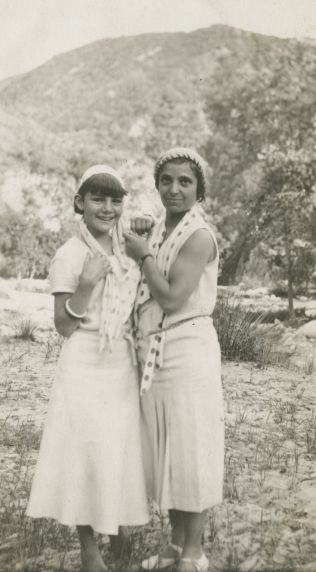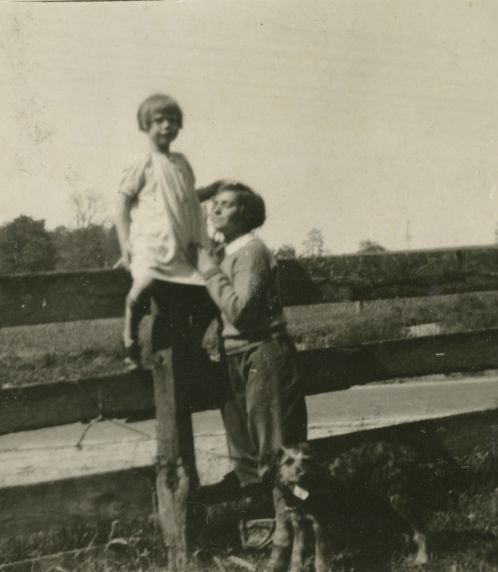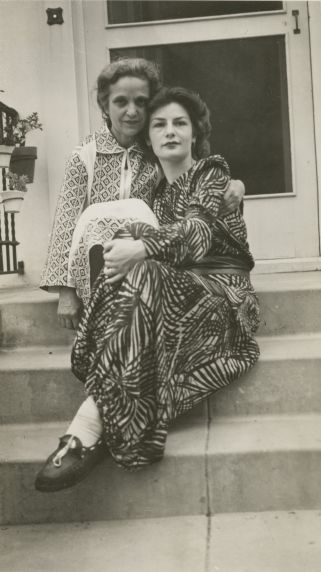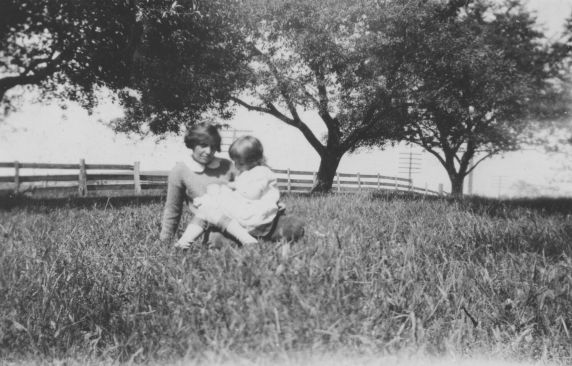Love Letters
Whether you celebrate the 14th of February or not, the day provides a good opportunity to take a closer look at some of the intimate stories contained within the Reuther's collections. While our purpose for collecting personal papers lies in their connections to organizations or social movements that help our understanding of the history of labor, metropolitan Detroit, or Wayne State University, it is often impossible to separate the private person from his/her public accomplishments. There is perhaps no better example of this than the Matilda Robbins Papers and the story of a deep love contained within. It’s not the conventional love story, although there is evidence of Matilda’s well-publicized affair with another labor organizer, Ben Legere. Rather, this is the story of a mother’s love for her daughter, made all the more poignant by the circumstances and time period in which she chose to raise a child.
 Matilda Robbins is best known as an active member of the Socialist Party, labor organizer, and writer in the early 20th century, as industrial unionism was first gaining a foothold among America’s working classes. Like Elizabeth Gurley Flynn, she was one of few prominent women in the labor movement at that time. As impressive as that is, just as compelling is the fierce independence and self-determination with which she lived her personal life. A free-thinker, feminist, and poor immigrant worker, Matilda supported herself and her daughter in a time when unmarried motherhood was not just socially unacceptable, it was downright shocking. The inequality and injustices working class single women experienced in the Gilded Age was not lost on Matilda. Her collection contains many published and unpublished writings that expound on her observations, with titles such as “The Adoption” and “The Education of Shirley Shimmer.” What is remarkable is her seeming unflappability in the face of daily hardship, not least of which must have been bringing a child into the world all on her own. In reminiscences written in 1945, Matilda makes no excuses and declares “I have lived my life in accordance with what I felt and believed to be freedom of conscience and intellectual integrity.”
Matilda Robbins is best known as an active member of the Socialist Party, labor organizer, and writer in the early 20th century, as industrial unionism was first gaining a foothold among America’s working classes. Like Elizabeth Gurley Flynn, she was one of few prominent women in the labor movement at that time. As impressive as that is, just as compelling is the fierce independence and self-determination with which she lived her personal life. A free-thinker, feminist, and poor immigrant worker, Matilda supported herself and her daughter in a time when unmarried motherhood was not just socially unacceptable, it was downright shocking. The inequality and injustices working class single women experienced in the Gilded Age was not lost on Matilda. Her collection contains many published and unpublished writings that expound on her observations, with titles such as “The Adoption” and “The Education of Shirley Shimmer.” What is remarkable is her seeming unflappability in the face of daily hardship, not least of which must have been bringing a child into the world all on her own. In reminiscences written in 1945, Matilda makes no excuses and declares “I have lived my life in accordance with what I felt and believed to be freedom of conscience and intellectual integrity.”
 Her daughter, Vita, was born in 1919. A letter written to Vita by Matilda in 1962, a year before her death, recounts the difficulties surrounding Vita’s birth and Matilda’s confinement. Matilda writes about leaving New York with $400 to spend the summer months in Nantucket, where she delivered in the local hospital and stayed in a cabin owned by friends that had no modern conveniences, like indoor plumbing. The tone of the letter is somewhat matter-of-fact, but also exhibits Matilda’s determination to be a good mother and her enamoredness with Vita. She begins the letter, “Forty-three years ago today you were born and I knew fulfillment. I wanted nothing more than survival and then only you. And from then on I became merely a fulcrum for your existence. I was commited [sic] irrevocably.”
Her daughter, Vita, was born in 1919. A letter written to Vita by Matilda in 1962, a year before her death, recounts the difficulties surrounding Vita’s birth and Matilda’s confinement. Matilda writes about leaving New York with $400 to spend the summer months in Nantucket, where she delivered in the local hospital and stayed in a cabin owned by friends that had no modern conveniences, like indoor plumbing. The tone of the letter is somewhat matter-of-fact, but also exhibits Matilda’s determination to be a good mother and her enamoredness with Vita. She begins the letter, “Forty-three years ago today you were born and I knew fulfillment. I wanted nothing more than survival and then only you. And from then on I became merely a fulcrum for your existence. I was commited [sic] irrevocably.”
Journal entries from her time on the island include one from August 5, 1919, written from her hospital bed: “It is evening of the fifth day. The slanting rays of the sun fall softly on my baby’s head. Is that why she smiles? How wonderful the smile! The birds sing low melodies. Lullabys [sic] to their young. My heart sings a lullaby to my baby.”
Among the many poems in Matilda’s papers is one written shortly upon her return to New York after Vita’s birth, that clearly demonstrates her warm feelings of motherhood:
REFUGE
How far away it seems,
The world of stress and woe;
The struggles of my friend,
The triumph of my foe.So blissfully serene am I;
My loved one at my side;
And snug within my peaceful heart
Sweet memories abide.O, happy infant! Sweetest guide!
Who promise golden years;
In your dear eyes the answer lies
To all my love and tears.
 These and other writings in the collection indicate that Matilda and Vita shared a close and loving relationship throughout their years together. Explore more about this remarkable woman in her personal papers and these related collections: Ben Legere Papers, John Beffel Papers, and IWW Records. View additional images in the Women of the IWW Image Gallery.
These and other writings in the collection indicate that Matilda and Vita shared a close and loving relationship throughout their years together. Explore more about this remarkable woman in her personal papers and these related collections: Ben Legere Papers, John Beffel Papers, and IWW Records. View additional images in the Women of the IWW Image Gallery.
Read Matilda’s life story, in her own words, with commentary and original drawings by her granddaughter, Robbin Legere Henderson, in the book Matilda Rabinowitz: Immigrant Girl, Radical Woman. A Memoir from the Early Twentieth Century.

![(37645) Matilda and Vita on the beach, [Massachusetts], probably 1921. (37645) Matilda and Vita on the beach, [Massachusetts], probably 1921.](https://reuther.wayne.edu/files/images/37645_0.preview.jpg)

 Reddit
Reddit Facebook
Facebook LinkedIn
LinkedIn